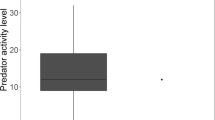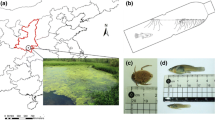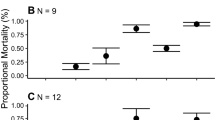Summary
Prey risk was examined in the laboratory to compare the ability of 6 Notonecta species to coexist with insectivorous fishes (Lepomis cyanellus, L. gibbosus). Because of their smaller size, lighter color, greater tendency to remain motionless in the presence of the predator, greater ability to avoid capture when attacked, and predicted lower profitability as prey, N. lunata and N. petrunkevitchi were estimated to have the lowest prey risk and greatest chance of coexisting with insectivorous fishes in nature. The 2 largest notonectids, N. irrorata and N. insulata, both highly melanistic and rapidly discovered by foraging sunfishes, were judged to be the most susceptible to predation by large fishes. The presence of vegetation as a potential refuge tended to decrease prey risk but did not significantly alter the relative risk among the prey species. Finally, the relative prey risk measured in the laboratory was consistent with the general distribution of these species in relation to fishes in local habitats. We suggest that fish predation is an important determinant of Notonecta habitat utilization patterns.
Similar content being viewed by others
References
Brooks JL, Dodson SI (1965) Predation, body size and composition of plankton. Science 150:28–35
Bullock TH (1953) Predator recognition and escape responses of some intertidal gastropods in the presence of starfish. Behaviour 5:130–140
Charnov EL (1976) Optimal foraging: attack strategy of a mantid. Am Nat 110:141–151
Confer JL, Blades PI (1975) Omnivorus zooplankton and planktivorus fish. Limnol Oceanogr 20:571–579
Crowder LB, Cooper WE (1982) Habitat structural complexity and the interaction between bluegills and their prey. Ecology 63:1802–1813
Dodson SI (1974) Adaptive change in plankton morphology in response to size-selective predation: a new hypothesis of cyclomorphosis. Limnol Oceanogr 19:721–729
Eggers DM (1977) The nature of prey selection by planktivorus fish. Ecology 58:46–59
Feder HM (1963) Gastropod defensive responses and their effectiveness in reducing predation by starfishes. Ecology 44:505–512
Giller PS, McNeill S (1981) Predation strategies, resource partitioning and habitat selection in Notonecta (Hemiptera/Heteroptera). J Animal Ecol 50:789–808
Hairston NG Jr, Li KT, Easter SS (1982) Fish vision and detection of planktonic prey. Science 218:1240–1242
Keast A, Welsh L (1968) Daily feeding periodicities, food uptake rates, and dietary changes with hour of day in some lake fishes. J Fish Res Board Can 25:1133–44
Kerfoot WC, Peterson C (1980) Predatory copepods and Bosmina: Replacement and further influences of predation on prey reproduction. Ecology 61:417–431
Macan TT (1966) The influence of predation on the fauna of a moorland fish-pond. Arch fur Hydrobiol 61:432–452
Macan TT (1977) The influence of predation on the composition of fresh-water animal communities. Biol Rev 52:45–70
Mittelbach GG (1981) Foraging efficiency and body size: a study of optimal diet and habitat use by bluegills. Ecology 62:1370–1386
Morin PJ (1984) The impact of fish exclusion on the abundance and species composition of larval odonates: results of shortterm experiments in a North Carolina farm pond. Ecology 65:53–60
Peckarsky BL (1980) Predator-prey interactions between stoneflies and may-flies: behavioral observations. Ecology 61:932–943
Sih A (1982) Foraging strategies and the avoidance of predation by an aquatic insect, Notonecta hoffmanni. Ecology 63:786–796
Sokal RR, Rohlf FJ (1981) Biometry, WH Freeman and Co San Francisco
Stein RA, Magnuson JJ (1976) Behavioral response of crayfish to a fish predator. Ecology 57:751–761
Streams FA, Newfield S (1972) Spatial and temporal overlap among breeding populations of New England Notonecta. U Conn Occas Papers (Biol Sci Ser) 2:139–157
Streams FA, Shubeck TP (1982) Spatial structure and intraspecific interactions in Notonecta populations. Env Ent 11:652–659
Taylor OR (1968) Coexistence and competitive interactions if fall and winter populations of 6 sympatric Notonecta (Hemiptera: Notonectidae) in New England. U Conn Occas Papers (Biol Sci Ser) 1:109–139
Vinyard GL, O'Brien WJ (1976) Effects of light and turbidity on the reactive distance of bluegill (Lepomis macrochirus). J Fish Res Board Can 33:2845–2849
Von Ende CN (1979) Fish predation, interspecific predation, and the distribution of 2 Chaoborus species. Ecology 60:119–128
Ware DM (1971) Predation by rainbow trout (Salmo gairdneri): the effect of experience. J Fish Res Board Can 23:1923–1956
Ware DM (1973) Risk of epibenthic prey to predation by rainbow trout (Salmo gairdneri). J Fish Res Board Can 30:787–797
Werner EE, Hall DJ (1974) Optimal foraging and the size selection of prey by the bluegill sunfish (Lepomis macrochirus). Ecology 55:1042–1052
Werner EE, Hall DJ, Laughlin DR, Wagner DJ, Wilsmann LA, Funk FC (1977) Habitat partitioning in a freshwater fish community. J Fish Res Board Can 34:360–370
Werner EE, Mittelbach GG, Hall DJ (1981) The role of foraging profitability and experience in habitat use by the bluegill sunfish. Ecology 62:116–125
Wright DI, O Brien WJ (1982) Differential location of Chaoborus larvae and Daphnia by fish: the importance of motion and visible size. Am Midl Nat 108:68–73
Zaret TM (1980) Predation and Freshwater Communities. Yale U Press New Haven.
Author information
Authors and Affiliations
Rights and permissions
About this article
Cite this article
Cook, W.L., Streams, F.A. Fish predation on Notonecta (Hemiptera): relationship between prey risk and habitat utilization. Oecologia 64, 177–183 (1984). https://doi.org/10.1007/BF00376868
Received:
Issue Date:
DOI: https://doi.org/10.1007/BF00376868




